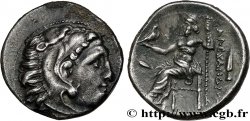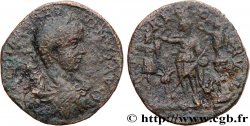v41_0129 - MACEDONIA - REGNO DE MACEDONIA - FILIPPO III ARRIDAIOS Tétradrachme
MONNAIES 41 (2009)
Prezzo di inizio : 300.00 €
Valutazione : 450.00 €
Prezzo realizzato : 300.00 €
Numero di offerte : 1
Offerta maxima : 455.00 €
Prezzo di inizio : 300.00 €
Valutazione : 450.00 €
Prezzo realizzato : 300.00 €
Numero di offerte : 1
Offerta maxima : 455.00 €
Tipo : Tétradrachme
Data: c. 323-320 AC.
Nome della officina / città: Chypre, Citium
Metallo : argento
Diametro : 27 mm
Asse di coniazione : 12 h.
Peso : 17,05 g.
Grado di rarità : R1
Commenti sullo stato di conservazione:
Exemplaire sur un flan large, légèrement irrégulier. Revers de très joli style. Jolie patine avec des reflets dorés et bleutés irisés au droit
N° nelle opere di riferimento :
Diritto
Titolatura diritto : ANÉPIGRAPHE.
Descrittivo diritto : Tête d'Héraklès à droite, coiffée de la léonté.
Rovescio
Descrittivo rovescio : Zeus aétophore, les jambes croisées, assis à gauche sur un siège avec dossier, nu jusqu'à la ceinture, tenant un aigle posé sur sa main droite et un long sceptre bouleté de la gauche ; les pieds reposent sur un marchepied.
Legenda rovescio : BASILEWS/ ALEXANDROU/ TK
Commento
Pour Citium, le titre Basileos est toujours présent au revers. Sachant que l’atelier ferme provisoirement vers 320 avant J.-C., nous avons d’abord des tétradrachmes où les jambes de Zeus sont parallèles, puis croisées ce qui permet d’affiner la chronologie des émissions. Normalement, avec les jambes croisées, le monnayage est toujours posthume, frappé après la mort d’Alexandre, survenue à Babylone le 14 juin 323 avant J.-C.
For Citium, the title Basileos is always present on the reverse. Knowing that the mint temporarily closed around 320 BC, we first have tetradrachms where Zeus's legs are parallel, then crossed, which allows us to refine the chronology of the issues. Normally, with crossed legs, the coinage is always posthumous, struck after the death of Alexander, which occurred in Babylon on June 14, 323 BC
For Citium, the title Basileos is always present on the reverse. Knowing that the mint temporarily closed around 320 BC, we first have tetradrachms where Zeus's legs are parallel, then crossed, which allows us to refine the chronology of the issues. Normally, with crossed legs, the coinage is always posthumous, struck after the death of Alexander, which occurred in Babylon on June 14, 323 BC








 Segnalare un errore
Segnalare un errore Stampate la pagina
Stampate la pagina Condividi mia selezione
Condividi mia selezione Fai una domanda
Fai una domanda Consegnare / vendere
Consegnare / vendere
 Descrittivo
Descrittivo















